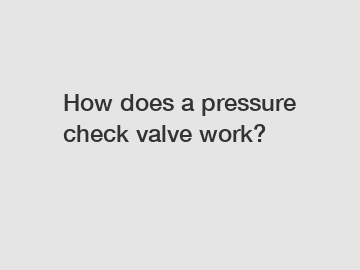How does a pressure check valve work?
Pressure check valves are essential components in various industries, including plumbing, oil and gas, and manufacturing. These valves play a crucial role in maintaining the flow of liquids or gases in a single direction while preventing backflow. Understanding how a pressure check valve works is essential for proper installation and maintenance, ensuring optimal performance and safety.
### Function of a Pressure Check Valve.
A pressure check valve, also known as a non-return or one-way valve, is designed to allow fluid or gas to flow in one direction only. When the pressure on the inlet side is greater than the pressure on the outlet side, the valve opens, allowing the flow to continue. However, when the pressure on the outlet side exceeds the inlet pressure, the valve closes, preventing backflow.

### Types of Pressure Check Valves.
There are several types of pressure check valves, each designed for specific applications based on factors such as flow rate, pressure, and the type of fluid or gas being handled. Some common types of pressure check valves include:
- Swing Check Valve: This type of valve has a hinged disc that swings open in the direction of flow and closes to prevent backflow.
- Lift Check Valve: Lift check valves use a guided disc that moves up and down to open and close the valve.
- Diaphragm Check Valve: Diaphragm check valves use a flexible diaphragm to control the flow of fluids or gases.
- Wafer Check Valve: Wafer check valves are designed to fit between two flanges and are used in applications where space is limited.
### Working Principle of a Pressure Check Valve.
The working principle of a pressure check valve is relatively simple yet effective. When the pressure on the inlet side of the valve is greater than the outlet pressure, the valve opens, allowing the fluid or gas to flow through. The force of the pressure differential keeps the valve open.
However, when the pressure on the outlet side exceeds the inlet pressure, the valve closes, preventing backflow. This action is achieved through the use of a spring, hinge, or diaphragm, depending on the type of valve. The design of the valve ensures that it operates automatically without the need for external controls.
### Importance of Pressure Check Valves.
Pressure check valves play a critical role in various applications where backflow prevention is essential. In plumbing systems, these valves prevent contaminated water from flowing back into the main water supply, ensuring the safety of the drinking water. In industrial applications, pressure check valves protect equipment and pipelines from damage caused by backflow, such as water hammer or reverse flow.
### Maintenance of Pressure Check Valves.
Proper maintenance of pressure check valves is essential to ensure their reliable and efficient operation. Regular inspection and testing of the valves are recommended to check for any signs of wear, corrosion, or leakage. Cleaning and lubricating the valves as needed can help improve their performance and extend their lifespan.
In conclusion, pressure check valves are vital components in various industries, serving the crucial function of preventing backflow and ensuring the safe and efficient flow of fluids or gases. Understanding how these valves work and the importance of proper maintenance is essential for ensuring optimal performance and safety in any application.
If you have any questions or need assistance with pressure check valves, feel free to contact us.
If you want to learn more, please visit our website hydraulic two way flow control valve, wholesale Pilot Operated Sequence Valve, rotary directional valve supplier.

Comments
0